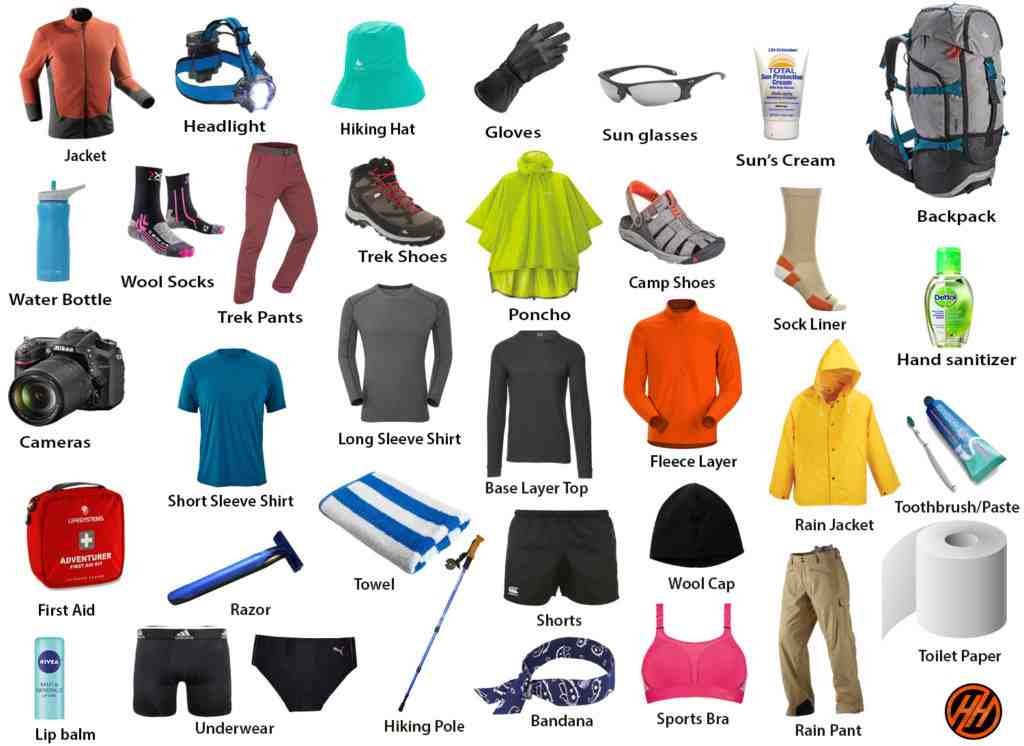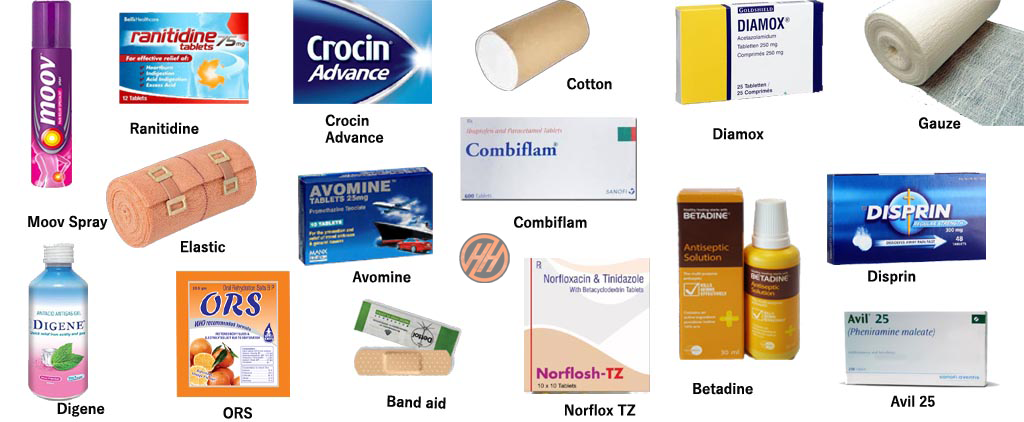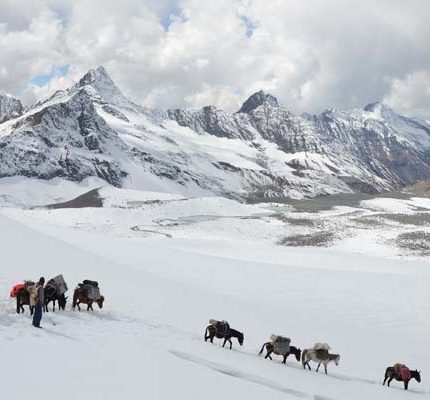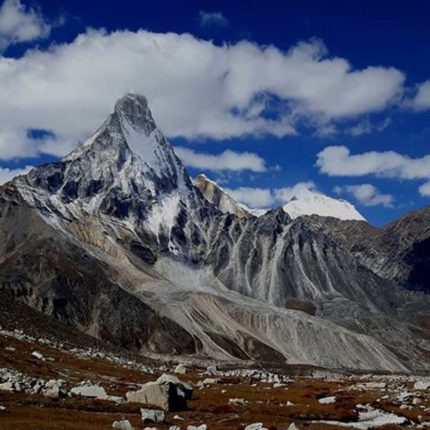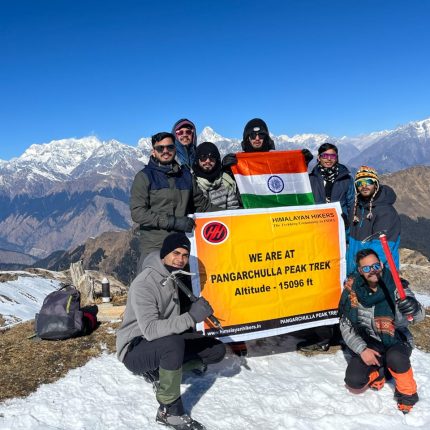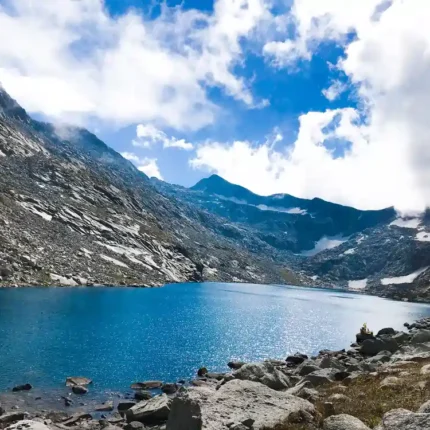Price:₹3,000.00
Kareri Lake Trek: A 3-Day Himalayan Journey to Crystal Waters & Alpine Serenity
The Kareri Lake Trek is one of the most stunning and accessible Himalayan treks in Himachal Pradesh. It is situated at an altitude of 9,700 ft, which makes it an ideal trekking destination for beginners and seasoned trekkers. The Kareri Lake is a glacial freshwater lake fed by the melting snow of the Dhauladhar range. This lesser-known trek in Himachal combines scenic trails of Rhododendron trees, panoramic mountain views, and the Niyund Nallah that follows you from the starting point of the Kareri Lake trek (Nolli Bridge).
The trek begins from Kareri Village base camp, it’s a peaceful village located about 25 km from Dharamshala via Ghera Village, making it one of the most sought-after short treks in North India.
The Kareri Lake trek takes 3 days and 2 nights to complete, during which trekkers ascend from 4,750 ft to 9,700 ft, passing through pine forests, wooden bridges, and alpine meadows. The well-paced itinerary includes a night halt at the Reoti bridge campsite, a full-day excursion to Kareri Lake.
The best time to visit Kareri Lake trek is from May to June and September to November, when the weather is clear and the trails are most accessible. Thanks to its moderate terrain, this trek is considered easy to moderate, making it ideal for first-timers and families.
So, whether you are searching for an offbeat Himalayan trek, a quick weekend adventure with your family or friends, then the Kareri lake trek is definitely one of the best treks in Himachal to put in your bucket list.
Who Can Do the Kareri Lake Trek?
- Anyone who is above the age of 12 years and below 62 years.
- First-timers are also welcome to do this easy-to-moderate trek.
- Has a good level of physical fitness.
Why should you do the Kareri Lake Trek?
Kareri Lake: A high-altitude glacial lake famous for its super clear water and the way it mirrors the mountains around it. It’s a calm, beautiful spot that makes for a great ending to a scenic hike through the Himalayas.
Kareri Devi Temple: A small temple dedicated to the Kareri Goddess is located near the lake. That adds spiritual charm and cultural depth to the natural beauty of the Kareri Lake trek.
Dharamshala: A vibrant town in Himachal Pradesh that serves as the gateway to the Kareri Lake trek, known for its Tibetan culture, cafes, monasteries, and stunning views of the Dhauladhar mountains.
Dhauladhar Range: The Dhauladhar Range rises high above the trail, giving the trek stunning mountain views. You can often see snow-capped peaks from different spots along the way, making the whole experience even more memorable.
Easy Trail: The trail is pretty easy, great for first-timers, families, or anyone wanting a quick Himalayan trip without pushing too high in altitude. That said, a few parts can be tricky and might be hard to get through if you’re trekking alone or without a guide.
Kareri Village: A cozy mountain village in the Himalayas acts as the starting point for the trek. It shows what life is like in Himachal villages, with friendly people, warm welcomes, and stunning views of Rhododendron trees and terraced farms.
Short Itinerary of Kareri Lake Trek
Day 1: Dharamshala to Kareri Village Drive and Trek to Reoti Bridge Campsite
Altitude Gain: 5,900 ft to 8,000 ft | Drive Distance: 25 km | Drive Duration: 2 hours | Trek Distance: 6 km | Trek Duration: 4 to 5 hours | Overnight Stay: Tents | Trek Difficulty: Easy
Highlights:
Start with a scenic 2-hour drive from Dharamshala to Kareri Village, enjoying stops like Ghera. From Nolli Bridge, trek 6 km through shaded pine and rhododendron forests to the Reoti Bridge campsite. Arrive by late afternoon and spend the night camping under the stars.
Pro tip: Make sure you have sufficient cash, the last reliable ATM point is in Dharamshala.
Day 2: Trek to Kareri Lake and back to Reoti
Altitude Gain and Loss: 8,000 ft to 9,700 ft to 8,000 ft | Trek Distance: 14 k | Trek Duration: 7 to 8 hours | Overnight Stay: Tents | Trek Difficulty: Easy to Moderate
Highlights:
After breakfast, start the 14 km round-trip trek to Kareri Lake at 9,700 ft. The trail follows the Nyund Nallah stream and offers stunning views of the Dhauladhar Range. Visit the Kareri Devi Temple at the lake before returning through alpine meadows and forests, reaching the campsite around sunset for another night under canvas.
Day 3: Descend from Reoti to Kareri Village | Drive back to Dharamshala
Altitude Loss: 8,000 ft to 5,900 ft | Trek Distance: 6 km | Trek Duration: 3 to 4 hours | Trek Difficulty: Easy | Drive Distance: 25 km | Drive Duration: 2 hours | Drop Location: Dharamshala Bus Stand
Highlights:
Start your day with a peaceful morning at the campsite before embarking on the 6 km descent back to Kareri Village. After a short rest, participate in a photo and certificate ceremony with the trekking team. Then, drive 25 km back to Dharamshala, savoring your final views of the Himalayas. You will arrive Dharamshala drop point by early evening, carrying cherished memories of the mountain trails and alpine serenity.
What is the difficulty level of the Kareri Lake Trek?
The Kareri Lake Trek difficulty level is considered easy to moderate, making it one of the most approachable treks in Himachal. This is an ideal trek for beginners, families, and anyone looking for a manageable yet rewarding trekking experience. Below is a detailed breakdown of the key difficulty aspects of this trek:
- Trail Type & Terrain
The Kareri Lake trek route consists of a varied landscape, including well-trodden forest trails, rocky patches, and gentle ascents. Trekkers pass through lush pine and Rhododendron forests, walk alongside the Nyund Nallah stream, and navigate a few stream crossings. While some initial sections may be muddy or uneven, the trail is generally easy to follow and does not involve any technical climbing. The terrain offers just enough challenge to keep things exciting without being overwhelming.
- Trek Duration & Distance
The duration of the Kareri Lake Trek Itinerary includes 3 days and 2 nights, that covers around 26 kilometers in total trekking distance. Each day involves 4 to 5 average walking hours, which is comfortably paced and includes plenty of rest breaks. The trek’s manageable distance and duration make it ideal for people with basic fitness levels, and it does not demand extensive physical endurance or trekking equipment. There’s no need for mountaineering experience, making it a great entry-level Himalayan trek.
- Altitude Gain
The trek begins at Kareri Village (around 5,900 ft) and reaches a maximum altitude of 9,700 ft at Kareri Lake. This gradual elevation gain helps trekkers acclimatize naturally and minimizes the risk of altitude-related issues. Unlike higher-altitude treks like Miyar Valley Trek, Surya Top Trek, Kedarkantha trek, etc. this trek doesn’t require advanced acclimatization schedules, making it much safer and more comfortable for those who are new to high-altitude trekking in Himalayas.
- Who Is It Suitable For?
The Kareri Lake trek is suitable for beginners, solo travelers, families with children (above 12 years), and anyone in decent physical condition. You don’t need prior trekking experience for Kareri Lake Trek, though being able to walk comfortably for a few hours a day will make the journey more enjoyable. Basic fitness routines like walking, light jogging, or stair climbing can be useful as preparation in the weeks before the trek.
- Is the Kareri Lake Trek Safe for me?
Yes, the Kareri Lake Trek is safe for both beginners and experienced trekkers. The trail is well-defined, the altitude (9,700 ft) is manageable, and any risks are minimal with the right gear and preparation. Avoid trekking during the monsoon or heavy snowfall. Joining an organized group or hiring a guide adds extra safety and makes the journey more enjoyable.
- Key Tips for Trekking Comfortably
Here are some important tips for the Kareri trek that you can follow for a smooth and safe trekking experience:
- Wear sturdy trekking shoes with good grip to navigate uneven sections comfortably.
- Carry a lightweight backpack with essentials and stay hydrated.
- Do not rush over to complete the trek, maintain a proper rhythm to avoid physical strain and exhaustion.
- Take short breaks when needed and let nature soak into you.
Pro Tip: While some experienced trekkers attempt a Kareri Lake trek in one day, it’s generally advised to follow the three-day itinerary to fully enjoy the route and avoid overexertion.
What do we do for safety in Kareri Lake Trek?
At Himalayan Hikers, the safety of our trekkers is our highest priority. We understand that mountain trekking presents unique challenges, particularly in high-altitude environments like Kareri Lake. To address these challenges, we have implemented a comprehensive safety protocol to ensure that every trekker feels secure and well-supported throughout their journey.
Experienced Trek Leaders & Guides
All our treks are led by certified professionals with years of experience in the Himalayan terrain. They are trained in wilderness first aid and emergency response.
Planned Itinerary with Acclimatization Time
We design the route with adequate rest days and altitude gain to help trekkers adjust and avoid AMS (Acute Mountain Sickness).
Daily Health Monitoring & Medical Kits
Each day, we conduct basic health checkups using pulse oximeters and carry essential first-aid kits, oxygen cylinders, and altitude sickness medication.
Emergency Evacuation Backup
We maintain local emergency contacts and have tie-ups for quick evacuation support (by mule or vehicle) in case of serious issues.
Pre-Trek Briefings & Gear Checks
Before the trek, we conduct safety briefings and equipment checks to make sure everyone is properly prepared with the right gear and clothing.
Weather Monitoring & Route Flexibility
We constantly track mountain weather forecasts and adjust the plan if needed to avoid storms, heavy snow, or landslides.
Small Group Sizes for Better Supervision
We keep group sizes small to ensure that every trekker receives individual attention and support throughout the journey.
Safety Tips & Emergency Information for Kareri Lake Trek
Emergency Exits
While the Kareri Lake trek is relatively safe, it’s good to know your exit points in case of emergencies:
- The primary exit is to Kareri village, which is the starting and ending point of the trek. It’s reachable within a few hours from most midpoints on the trail.
- In case of altitude sickness or injury, mules or local porters can help you to descent back to the Kareri base camp quickly.
Nearest Hospital to Kareri Kale trek Base Camp
Zonal Hospital Dharamshala is the nearest Hospital to Kareri Lake Trek Base Camp and it’s 25 km away from Kareri village.
Zonal Hospital Dharamshala
- Location: Near Kotwali Bazaar, Dharamshala, Himachal Pradesh
- Distance from Kareri Village: Approximately 25 km 1.5–2 hours drive by road
- Type: Government hospital with emergency and general care facilities
Here are contact details of Zonal Hospital Dharamshala:
Contact: Email: pmiskangra@gmail.com
Phone: 01892-224874 Available via local emergency
For minor medical needs, small primary health centers (PHCs) are available in nearby villages. However, for more serious health concerns, the Zonal Hospital in Dharamshala is the recommended facility. Always remember to carry a personal first-aid kit and any necessary medications during your trek to ensure adequate preparedness for unforeseen circumstances.
Quick Safety Tips
- Hire a local guide if trekking independently because some sections can add difficulty to navigating properly.
- Avoid trekking during monsoon or peak winter for safety.
- Pack adequate warm layers, a rain jacket, and sturdy trekking shoes.
- Stay hydrated, take breaks, and avoid rushing, especially during descents.
What is the Best Time to Do the Kareri Lake Trek?
The best time to do the Kareri Lake Trek is during the summer (April to June) and autumn (September to November) seasons. These months offer ideal weather, clear trails, and stunning views of the Dhauladhar Range. While winter treks are possible for experienced adventurers, they come with more challenges. Let’s break it down season by season:
Summer Season (April to June)
Summer is one of the most popular times for the Kareri Lake trek. The weather is pleasant with daytime temperatures ranging from 10°C to 20°C. May & June are peak months to do the Kareri Lake Trek. The snow has mostly melted, and the forest comes alive with greenery and blooming wildflowers. Sky mostly remains clear offering excellent views of the surrounding peaks but you might experience occasional rainfall.
So, it is advised that you carry a raincoat or poncho to protect yourself from rain. The lake is fully accessible, and the skies are usually clear, offering excellent views of the surrounding peaks.
Why trek in summer?
- Best for beginners and first-time trekkers
- Clear, dry trails and moderate temperatures
- Vibrant natural landscapes and flowing streams
Monsoon Season (July to August): Not Recommended
While the Kareri Lake trek in monsoon showcases lush landscapes and powerful waterfalls, we strongly advise against trekking during these months due to:
- Safety concerns: Slippery trails, swollen streams, and potential landslides
- Navigation challenges: Obscured paths and landmarks
- Limited views: Frequent fog and cloud cover obscuring mountain vistas
- Difficult camping: Wet ground and persistent rainfall affecting camp comfort
The rainforest-like atmosphere created during monsoon months may seem appealing, but the significant safety risks outweigh the potential benefits for most trekkers.
Autumn Season (September to October)
Autumn is another excellent time for the Kareri Lake trek, especially if you prefer fewer crowds and crisp mountain air. Post-monsoon, the trail is fresh and clean, with golden hues beginning to color the forests. The skies are crystal clear, giving you some of the best views of the Dhauladhar Range.
Pro Tip: If you’re trekking independently and not part of an organized group, it’s highly recommended to hire a local guide. The trails can be confusing, with multiple branches and splits that may lead you off-route. A local guide not only ensures you stay on the right path but also enriches the experience with regional insights.
Why should you do Kareri Lake trek in autumn?
- Post-monsoon freshness and ideal weather
- Clear skies with stunning visibility
- Quieter trails and peaceful campsites
- Camping under starry night sky
Winter Season (January to March)
Winter transforms the Kareri Lake trek into a snow-covered wonderland. However, this season is only recommended for experienced trekkers with proper snow gear. The trail becomes more challenging, and access to the lake may be blocked by snow after heavy snowfall. Campsite conditions are harsh, and temperatures often dip below freezing.
Why (and when) to trek in winter?
- For the thrill of snow trekking and winter photography
- Only attempt with a guide and full winter equipment
- Trek may be limited to lower campsites depending on snow conditions
In summary, the best time to visit Kareri Lake trek is from April to June and September to October for a safe, scenic, and comfortable experience. Winter trekking is beautiful but best suited for experienced trekkers only.
Month-by-Month Kareri Lake Trek Conditions
| Month | Temperature Range | Trail Condition | Recommendation | Special Notes |
| January | -10°C to 5°C | Heavy snow | For experts only | Lake likely frozen |
| February | -8°C to 8°C | Deep snow | For experts only | Specialized equipment required |
| March | -5°C to 10°C | Snow patches | Moderate-Advanced | Early spring flowers begin |
| April | 5°C to 15°C | Mostly clear | Good | Early wildflowers appearing |
| May | 8°C to 18°C | Excellent | Highly Recommended | Peak wildflower season |
| June | 10°C to 20°C | Excellent | Highly Recommended | Perfect lake views |
| July | 10°C to 18°C | Wet & slippery | Not Recommended | Monsoon dangers |
| August | 10°C to 18°C | Wet & slippery | Not Recommended | Monsoon dangers |
| September | 8°C to 18°C | Drying out | Very Good | Post-monsoon freshness |
| October | 5°C to 15°C | Excellent | Highly Recommended | Clearest mountain views |
| November | 0°C to 12°C | Good, cooling | Good | Early morning frost possible |
| December | -5°C to 8°C | Snow begins | Advanced trekkers | Winter equipment needed |
How Can I Reach Kareri Lake Trek?
Reaching the Kareri Lake Trek involves first arriving in Dharamshala. It’s well connected from major cities of India like Delhi, Kolkata, Chennai, Bangalore, Mumbai, Ahmedabad, Lucknow, etc. via Air, Road, and Train heads.
- Kangra-Gaggal Airport is the nearest airport to Dharamshala, and it is about 15 km by road.
- Dharamshala ISBT is the Kareri Lake trek pickup location and the closest bus station to the Kareri Lake trek. It’s easy to get to from other parts of India since there are regular government buses, so you can reach here fairly easily on schedule.
- Pathankot Railway Station (Punjab) is the closest train station to Dharamshala, and it is about 86 km from Dharamshala.
How to Reach from Dharamshala to Kareri Village Basecamp
Dharamshala ISBT is the Kareri Lake trek pickup location. You are expected to arrive here at 7:00 am. Himalayan Hiker’s team will receive you there and brief you about the trek. From there, the Himalayan Hikers team will take you to Kareri Village basecamp for the trek. Here’s a step-by-step Kareri village trek route to help you plan your journey.
- Reach Dharamshala, Kangra district of Himachal, Pick-up Location by 7:00 AM
- Drive to Ghera Village (about 13 km from Dharamshala)
- Kareri Village (25 km from Dharamshala and 12 km from Ghera Village)
- Nolli Bridge is the Kareri lake trek starting point, which is only 3 km from the Kareri village base camp.
How to Reach Dharamshala for Kareri Lake Trek?
By Air:
The nearest airport is Gaggal Airport (DHM), also known as Kangra Airport, located about 15 km from Dharamshala. It is well-connected to major cities like Delhi and Chandigarh. From the airport, take a cab or local transport to reach Dharamshala.
By Train:
The closest major railway station is Pathankot (PTK), about 85 km from Dharamshala. From Pathankot, you can hire a taxi or board a bus to reach Dharamshala (takes ~3–4 hours).
By Road:
Dharamshala is well-connected by overnight Volvo buses and state-run buses from Delhi, Chandigarh, and other North Indian cities. The journey from Delhi takes about 11–12 hours by road.
ATM Point and Mobile Connectivity in Kareri Lake Trek
ATM Availability
The last reliable ATM is in Dharamshala. Kareri Village and nearby areas do not have ATM facilities, so withdraw cash from the Dharamshala city.
Network Connectivity
- Mobile signal is available in Dharamshala and partially in Kareri Village, depending on your network provider. Jio and Airtel network works in Kareri Village.
- There is no network connectivity during most of the trek, especially beyond Kareri Village and near the lake.
- Inform your contacts and complete important calls before starting the trek. Enjoy the digital detox!
Tips:
- Withdraw Cash: Ensure you carry enough cash from Dharamshala to cover all your trek expenses.
- Pre-Download Maps: Internet access is patchy beyond Nolli Bridge, which is the starting point of Kareri Lake trek. So, make sure to download offline maps, trail guides, and inform your family or friends about your trek schedule before you leave Kareri base camp.
- Emergency Contacts: Keep a physical or digital copy of key emergency numbers, and inform a friend or family member about your Kareri Lake trek itinerary.
- Power Banks Are a Must: Carry at least one fully charged power bank, as electricity at the Reoti bridge campsite may be limited or unavailable.
How to Prepare for the Kareri Lake Trek?
Proper preparation ensures that your Kareri Lake Trek is enjoyable, safe, and stress-free. Especially since it’s a high-altitude trek, even if it’s considered easy. Here’s how to get yourself physically and logistically ready for the journey:
1. Physical Fitness
The Kareri Lake Trek difficulty level is easy to moderate, but it still involves walking 6 to 8 km per day, with steady climbs and descents. To prepare:
- Start light cardio exercises 3–4 weeks before the trek (brisk walking, jogging, cycling).
- Practice climbing stairs with a backpack to build stamina and leg strength.
- Do stretching or yoga to improve flexibility and reduce injury risk.
2. Essential Gear Checklist
Pack light but smart. Here’s what you’ll need:
- Trekking shoes with good ankle support and grip.
- Warm clothing in layers (thermals, fleece, waterproof jacket).
- Backpack (30–40L) with rain cover.
- Reusable water bottle, energy bars, and dry fruits.
- Trekking pole (optional but helpful on descents).
- Personal first-aid kit, sunscreen, lip balm, and basic toiletries.
3. Timing Your Trek
Plan your trip between May–June or September–November for the best weather and trail conditions. Avoid monsoon and heavy snow seasons unless you’re an experienced trekker with proper winter gear.
4. Travel & Logistics
- Reach Dharamshala one day before the trek; it’s the main pickup point.
- If trekking solo, hire a local guide—the trail has several confusing branches.
- Pre-book your homestay or campsite at Kareri Village to ensure a smooth start.
5. Mental Preparation
- Be mentally ready for basic mountain life—no network, simple food, and shared tents.
- Embrace the experience of disconnecting and connecting with nature.
With the right mindset, preparation, and gear, the Kareri Lake Trek becomes an unforgettable and accessible Himalayan adventure for almost anyone.
What to Expect on the Kareri Lake Trek: Terrain, Views & Experience
The Kareri Lake Trek is a perfect blend of serene landscapes, accessible trails, and immersive mountain charm. Whether you’re a first-time trekker or a seasoned hiker looking for a short Himalayan escape, here’s what you can expect in terms of terrain, views, and overall experience:
Terrain: Forests, Streams & Serene Glacial Lake in Meadows
The trail begins in Kareri Village and quickly leads you into dense oak and pine forests, offering shade, chirping birds, and cool mountain air. You’ll walk alongside Nyund Nallah, a glacier-fed stream, and cross rustic wooden bridges. The terrain is mostly a gentle ascent, with some rocky and muddy sections, especially near the water crossings. As you approach Kareri Lake, the forest opens into alpine meadows with occasional steep stretches.
Views: Mountains, Lake & Himalayan Vistas
Throughout the trek, you’ll be rewarded with spectacular views of the Dhauladhar Range, which loom large over the trail. At higher altitudes, the landscape becomes more open, revealing snow-capped peaks, open valleys, and glacier-fed water streams. The highlight, of course, is Kareri Lake itself—a pristine, mirror-like lake surrounded by rocks, greenery, and mountain silence. On clear days, the reflection of the sky and peaks in the lake is truly mesmerizing.
Experience: Calm, Culture & Natural Beauty
Expect a peaceful, non-commercialized trek with limited network connectivity, perfect for a digital detox. You may encounter Gaddi shepherds, pass traditional huts, and enjoy local Himachali hospitality at the base village. Nights are spent under star-lit skies at campsites like Reoti, where the only sounds are those of the forest and stream.
Top Attractions on the Kareri Lake Trek
1. Kareri Devi Temple
Located on the banks of Kareri Lake, this ancient stone temple is dedicated to Goddess Kali, revered by locals as the guardian of the region. The temple is a quiet spiritual spot, often visited by local villagers and shepherds, adding a cultural and religious layer to the otherwise nature-focused trek.
2. Kareri Lake Itself
A stunning glacial-fed high-altitude lake, Kareri Lake is known for its crystal-clear waters, which reflect the surrounding peaks and sky like a mirror. It sits amidst green meadows and rugged boulders at the foot of the Dhauladhar Range. The lake stays so clear because of the snowmelt from nearby glaciers. Since it’s also an important spiritual place, people are advised not to swim or camp right next to the water. It’s a really great spot for peaceful reflection, photography, or quiet admiration of nature’s beauty.
3. Dhauladhar Range Views
Throughout the trek, you’ll be treated to expansive views of the Dhauladhar mountain range, with its jagged, snow-dusted peaks rising dramatically against the sky. These mountains, part of the outer Himalayas, form the dramatic backdrop to the lake. Sunrise and sunset paint the peaks in golden hues, especially from Reoti or near the Kareri lake, which offers some of the most rewarding visual moments of the entire trek.
4. Nyund Nallah Stream
The Nyund Nallah is a glacier-fed stream that flows from Kareri Lake down through the valley, and much of the trek follows its path. Its gentle gurgle becomes a soothing companion as you hike through the forest. You’ll cross it multiple times via makeshift bridges or stepping stones, adding a fun, adventurous touch to the journey. It also serves as a natural water source at many points along the trail.
5. Gaddi Tribal Huts
As you ascend, you may come across stone-built huts used by the Gaddi tribe, semi-nomadic shepherds native to the region. These temporary shelters, often roofed with flat stones and built near grazing meadows, are part of the transhumance lifestyle—where families move livestock seasonally in search of pasture. Spotting these huts offers a rare cultural insight into mountain life that remains largely unchanged for generations.
6. Dense Oak & Pine Forests
The trail winds through lush forests of oak, pine, and rhododendron, providing a cool, shaded corridor filled with mountain flora and birdsong. In spring, you may find blooms of wildflowers, while in autumn the leaves take on golden-red tones. The forest not only offers natural beauty and tranquility, but also a habitat for local wildlife such as langurs, pheasants, and even occasional sightings of barking deer.
7. Peaceful Campsites like Reoti
Reoti is one of the most picturesque and tranquil campsites along the trek. Nestled amidst open meadows and beside a stream, it offers stargazing at night and soft golden light at sunset. Surrounded by tall trees and open sky, it’s the perfect place to relax after a day’s hike. These campsites provide shared tent accommodations and a cozy atmosphere, often enhanced by the warmth of a campfire and simple, hot mountain meals.








